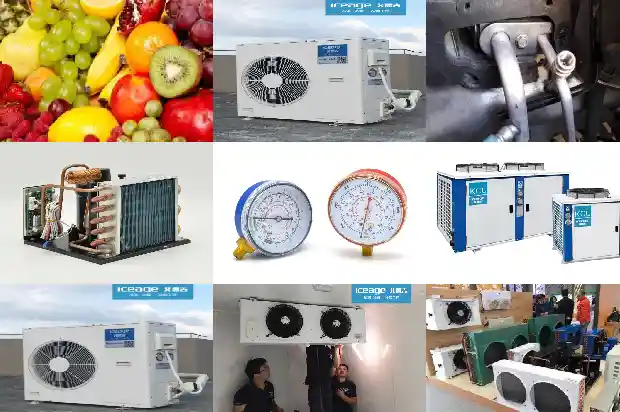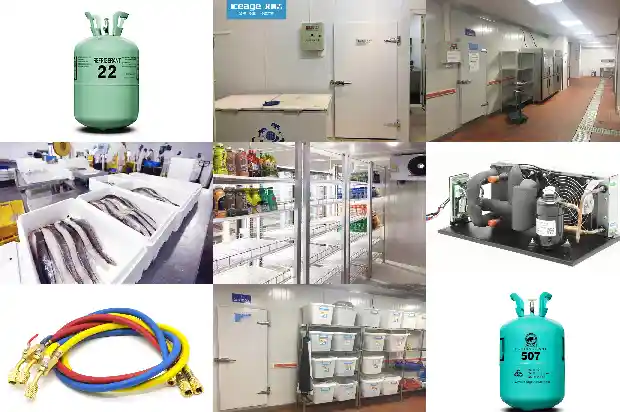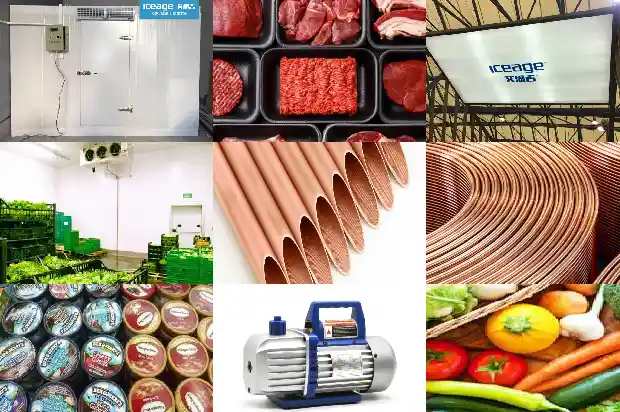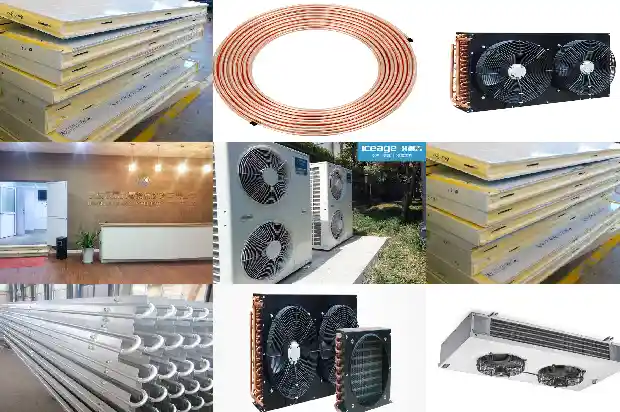9 Heating and Cooling Solutions: Pros and Cons You Must Know!
2025-01-07
Conventional Electric Refrigeration Air Conditioning System
The air conditioning system that is currently widely used has developed for more than a century. There are various forms of refrigeration main units, with the advantages of high refrigeration efficiency and so on.

Advantages:
- The system is simple and occupies a slightly smaller area than other forms.
- It has high efficiency and the COP (Coefficient of Performance) is generally greater than 5.3.
- The equipment investment is less than that of other systems.
Disadvantages:
- The quantity and capacity of the water chiller units are relatively large, and correspondingly, the quantity and capacity of other electrical equipment also increase, which increases the maintenance and repair workload.
- The total power load is large, increasing the transformer distribution capacity and the cost of distribution facilities.
- The electricity used is all peak electricity, and it does not enjoy the peak-valley electricity price policy, resulting in high operating costs.
- When the power is cut off, the air conditioner cannot be used. In the summer of 2003/2004, the air conditioning main units were halved in operation, resulting in most central air conditioners failing to achieve the intended use effect.
- The operation mode is inflexible. In the transitional season, holidays or rest time, when individual areas need cooling, the main unit needs to be started, resulting in a situation of "a big horse pulling a small cart", wasting the configuration capacity of the unit and increasing the operating costs.

- For large-scale regional cooling systems, it is difficult to achieve better cooling (the water supply temperature cannot be reduced), the investment in the pipe network is large, the energy consumption for transmission is high, and the air conditioning quality is poor.
Ice Storage Air Conditioning System
The ice storage air conditioning system reduces the capacity of the refrigeration main unit and adds an ice storage device on the basis of the conventional water-cooled chiller unit system. It stores the cooling capacity in the form of ice during the low-price electricity period at night and releases it when cooling is needed during the day. This technology began to be applied in the United States in the 1930s and was vigorously developed by developed countries during the energy crisis in the 1970s. Judging from the development situation of more developed countries and regions such as the United States, Japan, South Korea and Taiwan, China, ice storage air conditioning has become the development direction of central air conditioning. For example, South Korea has decreed that buildings exceeding 2,000 square meters must adopt ice storage or gas air conditioning, and buildings in Japan exceeding 5,000 square meters consider adopting ice storage air conditioning systems in the design. Many countries have taken incentive measures to promote this technology. For example, South Korea rewards $2,000 at one time for transferring 1kW of peak electricity, and the United States rewards $500 at one time and so on.
China has also increased the promotion of energy storage technology. The State Planning Commission and the Economic and Trade Commission specially issued the "Measures for the Management of Electricity Conservation", requiring all units to promote energy storage technology and gradually increase the peak-valley electricity price difference. The air conditioning systems using energy storage technology across the country have increased significantly. The 100,000-square-meter Shanghai Science and Technology City where the APEC meeting was held in October 2001, the 130,000-square-meter new campus of Zhejiang University Zijingang, and the 5 million-square-meter Guangzhou University City and other large buildings all adopted the ice storage air conditioning system.
The ice storage central air conditioning represents the advanced level of central air conditioning in the world today and indicates the development direction of central air conditioning. It has the following characteristics.
Advantages:
- Reduce the capacity of the water chiller unit (reduce the one-time investment of the main unit), reduce the total power load, and reduce the transformer distribution capacity and the cost of distribution facilities.
- The refrigeration main unit has high refrigeration efficiency (COP greater than 5.3), and at the same time, by using the peak-valley load electricity price difference, the annual operating cost of the air conditioner is greatly reduced, and the operating cost can be saved by more than 35% (compared with heat pump and lithium bromide air conditioning forms, it can save more than 40%).
- Reduce the distribution capacity of the building, save the investment in substation and distribution, and save about 30% (the distribution investment of air conditioning); avoid the high reliability cost of double lines and save investment.
- It is flexible to use. The air conditioning in some areas can be provided by ice melting without starting the main unit, and the energy-saving effect is obvious.
- It can provide quantitative cooling by ice melting for a small load (such as only using individual offices) without starting the main unit.
- In the transitional season, it can provide quantitative cooling by ice melting without starting the main unit, and there will be no situation of "a big horse pulling a small cart", the operation is more reasonable, and the cost savings are obvious.
- It has an emergency function and improves the reliability of the air conditioning system. Its advantages are more obvious when the power is cut off: as long as there is power to drive the water pump (such as the power supply by the generator when the power is cut off), the ice can be melted to provide cooling, and the situation that the air conditioner cannot be used will not occur (in the summer of 2003/2004, the air conditioning main units were halved in operation, and most central air conditioners failed to achieve the effect, but the effect of the ice storage air conditioner was not affected).
- The refrigeration temperature is low and stable, the air conditioning effect is good, and the comfort and grade of the building are improved.
- There is a low-temperature cold source, the refrigeration speed is fast, and the start-up time before work is short. The longer the start-up time before work, the more ineffective operation of the air conditioner and the greater the unnecessary waste.
- As the driving energy, it is clean, environmentally friendly, stable, simple and reliable, and the peak-valley electricity price difference will inevitably be more favorable in the near future (the surrounding provinces have greatly reduced the price last year, and the peak-valley difference abroad is even greater).
- For large multi-building regional cooling, low-temperature water supply can be provided, reducing the energy consumption of water supply and the investment in the pipe network; at the same time, compared with the form of one cooling station for each building, investment can be saved, management costs can be reduced, and the area of the equipment room can be reduced (such as the 5 million-square-meter Guangzhou University City, the 130,000-square-meter new campus of Zhejiang University Zijingang, the 100,000-square-meter Hangzhou Business School, the 580,000-square-meter Hangzhou Citizen Center, etc.).
- It can provide low-temperature cold water for the end, reduce the investment at the end; strengthen the dehumidification capacity and greatly improve the air conditioning comfort; if a low-temperature air supply system is adopted, the fan energy consumption at the end can be saved, the air conditioning quality can be improved, and the size and investment of the air duct can be reduced.
- The air conditioning system has a high degree of intelligence and can realize the fully automatic operation of the system. It also has an interface with the BAS of the building and is the most advanced air conditioning system in the world at present.
Disadvantages:
- If the main unit and ice storage devices and other equipment are all arranged in the refrigeration equipment room, the ice storage device needs to occupy a certain space (solution: it can be buried under the green belt, arranged in the useless space under the car ramp, etc.).
- The equipment investment in the equipment room is slightly higher than that of the conventional water-cooled electric refrigeration and lithium bromide unit systems.
- Ice storage air conditioning can only cool in summer and needs a heating system (it can use the heat exchange of the heat network for heating, and the capacity of the heat network is far lower than that required by the lithium bromide unit, only about 50% of the capacity).
Water Source Heat Pump Air Conditioning System
- Belongs to Renewable Energy Utilization Technology
The water source heat pump is a heating and air conditioning system that uses the solar energy resources stored in the earth's water bodies as the cold and heat sources for energy conversion. The water bodies that can be used include groundwater or rivers, rivers and lakes on the surface and the ocean. The surface soil and water bodies are not only a huge collector, collecting 47% of the solar radiation energy, more than 500 times the energy used by humans annually (the underground water body receives solar radiation energy indirectly through the soil), but also a huge dynamic energy balance system. The surface soil and water bodies naturally maintain a relatively balanced energy reception and dissipation. This makes it possible to use the almost infinite geothermal energy stored in it. Therefore, the water source heat pump is a technology that uses clean and renewable energy. - Easy to Measure and Charge
The power load of the air conditioner is at the user's location, so it is easy to measure and charge the air conditioner. This is very beneficial for users to reasonably use the air conditioning system, save the energy consumption of the air conditioning system, and fairly, justly and publicly allocate the air conditioning operation and management. - Safe and Reliable Operation
The air conditioning system of the water source heat pump unit can basically ensure that the air conditioning system is turned on according to the user's needs throughout the year, especially in the spring and autumn air conditioning transitional seasons, which is equivalent to a four-pipe air conditioning system. Generally, the supply and return water temperatures of the water source heat pump are relatively stable throughout the year, and the fluctuation range is far smaller than the change of air temperature. The water body is used as the cold source of the air conditioner in summer and the heat source of the air conditioner in winter. The relatively constant characteristic of the water body temperature makes the heat pump unit operate more reliably and stably, and also ensures the high efficiency and economy of the system. There is no difficult problem such as defrosting in winter for the air source heat pump. - High Efficiency and Energy Saving
The ambient water temperature available for the water source heat pump unit is 12 - 22 °C in winter, and the water temperature is higher than the ambient air temperature, so the evaporation temperature of the heat pump cycle is increased and the energy efficiency ratio is also increased. In summer, the water temperature is 18 - 35 °C, and the water temperature is lower than the ambient temperature, so the condensation temperature of refrigeration is reduced and the unit efficiency is improved. - Flexible Application
In some buildings, especially in the transitional season, some areas need cooling and some areas need heating. The water source heat pump can supply cooling and heating at the same time, which can realize the transfer and balance of the cooling and heating capacity in the building, thus reducing the energy consumption of the system.
The water-source ground-source air conditioner has been widely recognized for its excellent energy-saving and environmental protection characteristics. In 2006, the Ministry of Science and Technology of China took building energy conservation as the "Eleventh Five-Year" science and technology support program project, and the sixth topic was the application technology of water-source ground-source heat pump. In 2007, the "Two Sessions" took the comprehensive promotion of the application of energy-saving and environmental protection technologies as one of the important topics of the meeting. In just a few years, the water-source ground-source heat pump central air conditioner has developed vigorously in large and medium-sized cities, especially in economically developed regions such as Beijing, Shandong and the Yangtze River Delta, and has become a symbol of energy-saving and environmental protection high-end air conditioning system. At present, it is developing rapidly to the central and western regions, and various places have established water-source ground-source air conditioning demonstration projects, and the government also actively encourages enterprises and institutions to choose water-source ground-source heat pump air conditioners.
At present, climate warming seriously threatens the sustainable development of mankind, and dealing with climate change has become a major global challenge. In addition to natural factors, the causes of climate change are closely related to human activities, especially the degree of using fossil fuels and emitting carbon dioxide.
Energy conservation will inevitably become a necessary indicator to measure the quality of future buildings, and the concept of "low-carbon emission" is generally valued by academic research institutions in the environmental protection industry.
As the largest power-consuming equipment in buildings, the central air conditioning system should be the first to reduce energy consumption and emissions. According to the "Outline of China's Energy-saving Technology Policy", the development of geothermal, water source, air source heat pump technology and sewage source heat pump technology should generally not adopt the direct electric heating method. It is recommended to use cold storage and heat storage air conditioning and heating and make full use of the low-load of the power grid. The State Council document (Guo Fa (2008) No. 03) recommends the use of water source heat pump and ice storage technology for energy-saving technology.
Electric Heat Storage Air Conditioning System
The electric heat storage air conditioner uses the electric boiler to generate heat with the low-price electricity at night, stores the generated heat in the heat storage device in the form of hot water, and releases the stored heat to supply heat to the end of the air conditioner during the day.
The electric heat storage air conditioner has a stable heating capacity and has the following characteristics:
- Use energy storage technology to shift peaks and fill valleys, balance the load of the power grid, improve the utilization rate of power generation equipment in power plants, reduce the operating costs of power plants and power grids, and save the infrastructure investment of power plants and power grids.
- By using the peak-valley load electricity price difference, the annual operating cost of the air conditioner is greatly reduced.

- It is flexible to use. In the transitional season, holidays or after work, the air conditioning in some offices can be provided by heat storage quantitatively without starting the unit, the energy-saving effect is obvious, and the operating cost is greatly reduced.
- It has an emergency function and improves the reliability of the air conditioning system.
- It has a high degree of automation and can be unattended. It can track the changes of the air conditioner in real time and supply as much cooling capacity as needed, and there will be no situation of "a big horse pulling a small cart", and the energy-saving is obvious.
Air-cooled Heat Pump Air Conditioning System
The air-cooled heat pump is an air conditioning form that is cooled by outdoor air, and its refrigeration and heating performance is closely related to the outdoor ambient temperature. It has the following characteristics:
- It integrates cooling and heating and does not need to configure an additional heat source.
- When the influence on the building appearance and the vibration of the unit operation are not considered, the unit can be placed on the roof without the need for a special air conditioning equipment room. It is more suitable for small-area buildings without a refrigeration equipment room.
- It is air-cooled and does not need to configure a cooling tower.
- Relying on air cooling, the refrigeration and heating performance is closely related to the outdoor ambient temperature, resulting in unstable performance. When the outdoor temperature is high in summer and more cooling capacity is needed, its refrigeration capacity becomes worse; when the outdoor temperature is low in winter and more heating is needed, its heating capacity becomes worse. In winter, specific defrosting means are needed, which affects the heating effect; the heating temperature is low, and the indoor temperature cannot meet the requirements when it is cold.
- Relying on air cooling, the refrigeration efficiency is low (the nominal COP is lower than 3.2, and the actual operation is generally about 2.5), and the operating cost is high.
- Because the unit is placed outdoors and cooled by the wind, the condenser will be covered with dust after a long time, which greatly affects the heat exchange efficiency, the operation efficiency of the unit decreases, and the refrigeration capacity also decreases sharply. Generally, the refrigeration capacity needs to be re-evaluated and corresponding treatment is required after 3 years, and sometimes additional units need to be added.
- When selecting the unit, the influence of the environment on the system needs to be considered, and the configuration needs to be increased, resulting in increased investment, and the investment is the highest among several air conditioning forms.
- The efficiency is low, the total power load is large, increasing the already large transformer distribution capacity of the conventional air conditioning system, the cost of distribution facilities is high, and more electricity surcharge and electricity construction cost need to be paid.
- Because the unit is placed outdoors, the operation, management and maintenance are difficult, the unit is easy to be damaged, and the maintenance workload is large.
- In the transitional season, when the cooling or heating capacity is reduced, its refrigeration or heating capacity reaches the highest level, resulting in a situation of "a big horse pulling a small cart", which causes waste and also increases the operating cost.

Lithium Bromide Air Conditioning System
The lithium bromide unit uses heat energy as the energy of the unit and achieves the purpose of refrigeration through the absorption and release between lithium bromide and water and the refrigerant cycle of water. According to the way of providing heat energy, the lithium bromide unit is divided into direct combustion type (fuel oil, gas or natural gas), steam type (steam from the heat network or steam provided by the prepared boiler) and hot water type (hot water from the heat network or hot water provided by the self-provided boiler).
Because water is used as the refrigerant and lithium bromide is used as the absorbent, the characteristics of the refrigeration main unit are completely different from those of other air conditioners. The advantages are as follows:
- The energy of the system is mainly heat energy, so the distribution capacity is small (about 1/3 of that of the conventional electric refrigeration and 1/2 of that of the ice storage system), and the power consumption during operation is small. (However, it still cannot operate during a power outage. Using a self-provided generator can only ensure some pumps, and the whole system cannot supply cooling. It is not like the ice storage system that can supply cooling by starting all pumps to melt ice; if the units are halved in operation in the summer of 2003, the air conditioning effect cannot be achieved, while the ice storage system can ensure the air conditioning effect.)
- It is more feasible to use it in occasions where waste heat is generated, such as steel mills and textile mills. The application of lithium bromide units in developed countries in Europe and America is
Related Articles
- Essential for Maintenance! Parameters and Phenomena of Normal Operation of Refrigeration and Heating Systems
- What are the Cooling and Heating Pressures of an Air Conditioner? How to Calculate the Optimal Refrigerant Quantity?
- What Key Steps Should Not Be Ignored in Installing an Air - source Heat Pump Heating System?
- Is the heating effect of air source heat pump air conditioner with enhanced vapor injection really good under low temperature conditions?
- Air-source heat pump: Principle of cooling and heating in one machine
- Common Faults and Solutions of Central Air - conditioning Chiller Units
- Common Faults and Corresponding Solutions of Chillers During Use
- Common Issues in Chiller Operation and Solutions
- Solutions to Common Compressor Failures
- Reasons and Solutions for High and Low Condensing Pressure in Air-cooled and Water-cooled Systems
- Centrifugal Compressor: 5 Common Fault Solutions
- Causes and Solutions for Elevated Pressure in Cold Storage
- High Power Consumption of Constant Temperature Freezer and Its Solutions
- What to Consider When Replacing R22 with Refrigerant R404A?
- Where Lie the Key Construction Technologies of the Ammonia Refrigeration System?
- Considerations in Selecting Packaged Air Conditioners and Their Heat Recovery Operations
- What Issues Should Be Noted in Cold Storage Installation and Construction?
- Conditions are Required for the Construction of Small - sized Cold Storages
